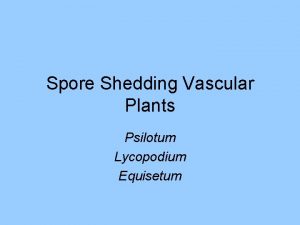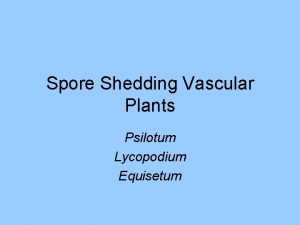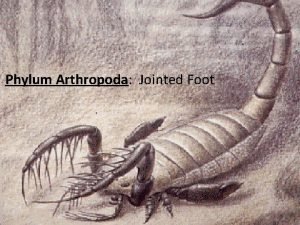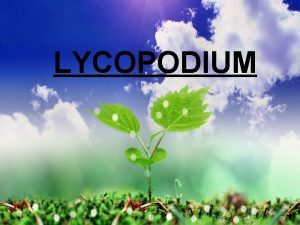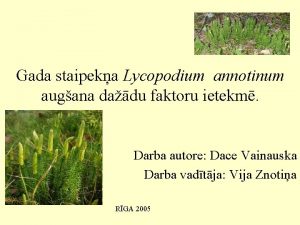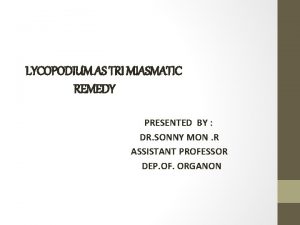LYCOPODIUM INTRODUCTION The modern representatives are small and











































- Slides: 43

LYCOPODIUM

INTRODUCTION The modern representatives are small and herbaceous sporophytes. The leaves are small and simple. Each leaf possesses an unbranched midrib. The leaves have no ligules. There are no leaf gaps in the stele of the stem. The sporophylls may or may not be restricted to the terminal portion of branches and organized into definite strobili. The sporophylls and simple vegetative leaves may be similar or dissimilar. They possess homosporous sporangia, i. e. , all the spores of one kind only. The gametophytes are wholly or partly subterranean. The antheridia remain embedded in the tissue of the prothallus. The antherozoids are biflagellate.

Classification • • • Genus LYCOPODIUM: Systematic Position: Pteridophyta Division. Lycophyta Class. Eligulopsida Order. Lycopodiales Family. Lycopodiaceae Genus. Lycopodium There about 180 species in this genus.

Distribution and habit: • The species of Lycopodium are world wide in distribution. They are mainly found in tropical and sub tropical forests. They are very commonly found on heaths and on humus soils in moist shady places. In India they are found in the hills of Eastern Himalayas. • The plants are commonly known as ‘ground pines’, ‘club mosses’ and ‘trailing evergreens’ many species occur in the tropics as hanging epiphytes (e. g. , Lycopodium phlegmaria and L. squarrosum). Chowdhury (1937) has reported eight species from our country. These species are: Lycopodium clavatum; L. cernuum, L. heamiltonii; L. setaceum; L. phlegmaria; L. wightianum; L. serratum and L. phyllanthum. The most common species is L. clavatum.

The Sporophyte • Habit: All species possess small, herbaceous or shrubby sporophytes. The stem in almost all the species is delicate and weak. Some species are epiphytic and with erect or pendant sporophytes while other species are terrestrial and have a trailing habit. The stem and its branches are densely covered with small leaves. Lycopodium phlegmaria is an epiphytic species. • According to Pritzel (1900) this genus is divided into two sub genera which differ from each other in general organization of the sporophyte. These subgenera are Urostachya and Rhopalostachya.

Stems • Species referred to the sub genus Urostachya possess branched or unbranched stems that are erect or pendant but never creeping. This subgenus includes the species, e. g. , L. selago, L. lucidulum, L. phlegmaria and others. If the stem is branched, the branching is always dichotomous. Usually the successive dichotomies are found at right angles to one another. The species belonging to this subgenus do not bear the adventitious roots along the stem.

Leaves • The leaves are small, simple, sessile, numerous and cover the axis closely. Typically the leaves are 2 to 10 mm long. Usually the leaves are arranged in closed spirals (e. g. , in L. clavatum and L. annotinum) while in other cases they are arranged in whorls (e. g. , in L. verticillatum and L. cernuum). • In some species the leaves are found to be arranged in opposite pairs (e. g. , L. alpimum); in others they are irregularly arranged. Usually the leaves are lanceolate

Apical growth • The apical growth of the shoot takes place by means of an apical meristem which consists of a group of apical cells.

Roots • The first root is short and at least in some species does not live long. The older plant bears the adventitious roots that arise singly or in groups acropetally along the lower side of the stem. The species of subgenus Urostachya do not possess adventitious roots along the stem. The species of the subgenus Rhopalostachya with a creeping stem generally have their adventitious roots borne along the entire length of the prostrate portion. • In some species, e. g. , L. selago, L. phlegmaria and others the roots that arise on the outside of the stele do not penetrate the cortical region of the stem at once. These roots turn downward and penetrate the soft middle cortex making canals through it, and ultimately they emerge only at the stem. Such roots are known as ‘cortical roots’ or ‘inner roots’. • In some species, (e. g. , L. obscurum and L. lucidulum) the branching of the roots is strikingly dichotomous. Here each successive forking is found at right angles to the preceding one. In many species the dichotomy is obscure. The endogenous lateral roots do not arise from the roots (as in seed plants). In terrestrial form the root hairs are found abundantly which persist over a long period.

Anatomy of the stem • A transverse section of the mature stem of Lycopodium clavatum shows the following structures: • The epidermis is one cell in thickness and has stomata that appear to be similar in structure to those of the leaf. The outer walls of the epidermal cells are thick and cutinized. • The cortex is quite broad and it varies greatly in relative thickness from species to species. In some species its radial thickness is several times that of the stele; in other species the two are approximately equal. The cortex has three zones. The peripheral and central zones consist of thickened sclerotic cells while the middle zone consists of larger and thin walled cells containing a few chloroplasts.

ENDODERMIS • The single stele occupies about half the area of the section. It consists of a number of irregularly shaped, parallel strands of xylem alternating with phloem bands. The xylem consists • Mainly of scalariform tracheids, with no vessels and no parenchymatous cells. Each Xylem plate remains surrounded by a single layer of parenchyma, with bordered pits on the inner walls, which lies between the xylem and the phloem. • The phloem is composed of sieve tubes and parenchyma only. The development of both xylem and phloem strands is centripetal, that is, from the periphery towards the cente.

. • The protoxylem consists of spiral and annular tracheids. The protoxylem is found to be situated at the outer edges of each xylem mass, that is to say, in the exarch position. • At the inner face of the cortex there may be an endodermal layer which, at least in younger portions of the stem has characteristic thickened radial walls. • The endodermis of Lycopodium is thought to be originated from the stele and not from the cortex. Internal to the endodermis there lies a multilayered pericycle. The pericycle layer is usually three to six cell in thickness

. • There is a great variation of organization of the vascular elements, not only in different species but even within the same species may vary both from individual to individual and in different portions of the same individual. In stems the vascular elements are found to be arranged into an exarch actinostele resembling to the actinosteles characteristic of roots of vascular plants. • In such steles the phloem lies in the space between the xylem plates. For example, in L. phlegmaria, the adult stem has the exarch actinostelic organization with rays of varying number. In L. serratum the xylem rays are expanded outwards like fan blades in appearance.

. • According to J. B. Hill (1914), the species with actinostelic type of organization in the older portions of the stem are thought to be the most primitive of the genus as far as the vascular organization is concerned. Other species may have plectostelic organization of the vascular elements. In such stems the xylem core is found in the form of plate like lobes. • Here the xylem and phloem bands are found to be arranged symmetrically in alternating transverse bands across the stele (e. g. , in L. volubile and L. wightianum). In still other species the stelic organization may have masses of xylem and phloem indiscriminately mixed with one another, e. g. , in L. cernuum. • Holloway (1910), Jones (1905) hold the view that the plectostelic organization is found chiefly in horizontal portions of the plant and the actinostelic in erect portions. The stele lacks a cambium in all cases and hence there is no secondary growth.

Anatomy of leaf • The transverse section of leaf shows following parts. • The leaf has a mid rib which consists of a single concentric amphicribral bundle. The central xylem core is quite small. It is not always differentiated into Meta and protoxylem. The xylem is composed of thick walled annular and spiral tracheids. The phloem is composed of phloem parenchyma and narrow sieve tubes. The endodermis is inconspicuous and may hardly be recognized. The vascular bundle remains surrounded by sclerenchymatous pericycle.

Anatomy of root • The transverse section of the root shows the following parts: • The root is differentiated into epidermis, cortex and stele like other vascular plants. The single layered epidermis gives rise to numerous root hairs. The root hairs are formed to be arranged in pairs. According to Stokey (1907), the occurrence of root hairs in pairs results from the fact that the hair initials are found in twos by the oblique or anticlinal division of a young epidermal cell.

. • Just beneath the epidermis there lies the broad cortex. The cortex is several cells in thickness and often becomes greatly sclerified in the outer half as the root becomes older. • In some cases the stele is monarch with the protoxylem in one mass, e. g. , in L. clavatum. In other cases the stele is diarch with two protoxylem masses, e. g. , in L. selago, L. reflexum and other species. Here the two xylem masses are united into one continuous xylem group which is C shaped or horseshoe shaped. • In still other cases the stele is triarch with three groups of protoxylem. According to Saxelby (1908), sometimes the same root is diarch in one portion and tetrarch in another (e. g. , in L. selago and others). Most roots are diarch. These roots generally have but one mass of phloem and this lies between the protoxylem points of the C or U shaped xylem.

The spore bearing organs • In most species of the subgenus Urostachya, the foliage leaves and sporophylls are approximately of the same size and both are green. However, there is variation in the distribution of foliage leaves and sporophylls. In Lycopodium selago and many other species there alternate sterile and fertile regions throughout length of stem and branches. These portions of the plant are called strobili. • The strobili of different species are varied from each other. The strobili of L. phlegmaria and other related species are dichotomously branched and here the sporophylls, although green and of the same shape are comparatively much smaller than the foliage leaves. • All species of the subgenus Rhopalostachya have the sporophylls in well defined strobili which may be simple or branched. The sporophylls may be differentiated from foliage leaves in that they are smaller in size, paler in colour and have a dentate margin.

Vegetative propagation of the sporophyte • The vegetative propagation is frequently found in the species of Lycopodium. Several methods of vegetative propagation are found in different species of Lycopodium. The species possessing creeping stems have the apical growth branching and the progressive death of the older portions. • According to Holloway (1917) the new plants may be developed from (a) vegetative propagation of the gametophyte, (b) vegetative propagation of the juvenile stage of the sporophyte, (c) gemmae produced from the cortical cells of the root, (d) tubers developed at the apices of roots and (e) bulbils. All above mentioned vegetative bodies are capable to develop into new plants.

. • The bulbils which are found only in species belonging to subgenus Urostachya resemble superficially to the protocormous stage (juvenile stage) of young sporophytes. The bulbils may develop anywhere on the stems. According to R. W. Smith (1920), these bulbils are interpreted as modified leaves while other workers interpret them as modified lateral branches or modified sporangia. • A sporophyll produces but one sporangium. The sporangium remains adaxial in its position and found near the base of the sporophyll. A mature sporangium is always kidney shaped. Each sporangium possesses a long and slender or short massive stalk, according to species.

Development of sporangium • The sporangia begin to develop at a time when the sporophyll is composed of embryonic cells. First of all there is a periclinal division of a small group of epidermal cells on the adaxial side of a sporophyll and near its base • The inner daughter cells formed by this periclinal division give rise to the stalk and the basal portion of a sporangium. The outer daughter cells contribute to the formation to the bulk of the sporangium. The outer cells again divide periclinally forming an outer layer, the jacket initials; and an inner layer, the archesporial cells.

• The archesporial cells divide periclinally and anticlinally forming a massive sporogenous tissue. The cells of the last generation of the sporogenous tissue act as spore mother cells. They become rounded and are being separated from one another. Now these spore mother cells float about in a viscous liquid and divide meiotically into tetrads of spores. • The jacket initials, which are found external to the sporogenous tissue divide repeatedly forming a jacket layer of three or more cells, in thickness. Shortly before the development of the spore mother cells a nutritive tapetal layer is formed around the sporogenous tissue. • This layer is partly formed from the inner most layer of jacket cells and partly from sporangial cells found just beneath the sporogenous tissue. As found in most other pteridophytes, in Lycopodium there is no disintegration of the Tapetum during spore formation.

Dehiscence of sporangium • The mature sporangium is about 2 mm across and kidney shaped. On the maturity of the sporangium narrow transverse strip of cells, the stomium is formed across the apical portion of the outermost jacket layer. • The cell walls of the stomial portion become thickened and may easily be differentiated from those of other cells present in the jacket layer of the sporangium. The mature sporangium ruptures by a transverse slit at its apex along the line of the stomium. The sporangium divides into two valves which remain united at the base and dehiscing the yellow spores.

The Gametophyte • The spore: • The small spores (about. 03 to. 05 mm. diameter) are uniform in size and shape, i. e. , homosporous. This way Lycopodium is similar to most of the ferns and Equisetum. The spores are round or tetrahedral in shape. They are very light possessing thin exine formed of concentric lamellae, and a granular intine. 1. Netzsporen This type of spores possess an outer wall with reticulate ridges (e. g. , in L. clavatum, L. complanatum and L. annotinum). 2. Tupfelsporen. This type of spores possess knob like outgrowths from the surface (e. g. , in L. selago and L. phlegmaria). 3. This is a transitional type possessing a fine ridged pattern (e. g. , in L. cernuum and L. inundatum).

Germination of spore and development of prothallus • The spores settle on the ground after their liberation from the sporangium and each germinates into a prothallus. Sometimes the germination of spore may, however, be delayed for years. According to Treub (1888), the spores germinate within a few days after they are shed (e. g. , in L. cernuum, L. inundatum and L. salakense). • In L. clavatum the spore germination begins after three to eight years of their shedding. Here the prothallus is a subterranean structure, solid and tuberous which takes from six to fifteen years to mature. The prothallus of L. clavatum is colourless and saprophytic and contains a mycorrhizal fungus.

Development of archegonium • The archegonium develops from a single superficial cell of prothallus found just back of the apical meristem. This cell is known as archegonial initial. The arcehegonial initial divides periclinally into a primary cover cell and central cell

• According to Bruchmann (1910), the first cell division of a germinating spore takes place before the outer spore wall (exine) is ruptured and results in two hemispherical daughter cells of approximately equal size. The lower or inner daughter cell also known as basal cell cuts off a small lens shaped rudimentary rhizoidal cell while the outer daughter cell divides twice successively producing an apical cell with two cutting faces. • In the species with subterranean colourless prothalli a long period of rest, about one year is required between the five celled stage and the mature prothallus. Upto four to five celled stage the early growth of the prothallus takes its nourishment from the reserve material contained in the mature spores.

• Thereafter 4 6 celled gametophytes may have an entrance of a symbiotic phycomycetous fungus into the basal cell. If there is no entrance of the fungus there is not further development of the gametophyte. After the establishment of the endophytic mycorrhiza within the cells of the young prothallus, the apical cell cuts of some half dozen segments and then becoming replaced by a group of meristematic cells. • The segments thus cut off by the apical cell divide periclinally, and the outer cells thus formed become infected with the symbiotic fungus in the same way as does the basal cell. The apical group of meristematic cells, which are formed early in the development of a gametophyte produces the major portion of the adult prothallus.

• There is great diversity in form and structure of mature gametophytes in the different species of Lycopodium. There are three main types of mature prothalli. They are as follows: • The first type of prothallus is mainly found in L. cernuum, L. obscurum and L. inundatum. Here the prothallus is inconspicuous and reaches to the maximum height of 2 to 3 mm and usually 1 to 2 mm in diameter. The prothallus grows on the surface of the ground. It is an upright fleshy structure whose lower portion remains embedded in the soil. • On its upper exposed part the prothallus bears green lobes with meristematic plates. The sex organs are found between the green expanded lobes. The prothallus can manufacture its own food, though an endophytic roycorrhiza is always present. Rhizoids are also produced from the prothallus.

. • The second type of prothallus is found in the species, e. g. , L. clavatum, L. complanatum, L. obscurum and L. annotinum. The prothalli are of various shades. They are brownish yellowish or colourless. They are saprophytic and found underground at various depths from one to eight centimeters. Much food material remains deposited in these tuberous prothalli. • .

• In L. clavatum the prothallus is much convoluted structure 1 to 2 cm. long with a pointed basal part. The surface is covered with an epidermis. Inside the epidermal layer there is a cortex of several layers. Just beneath the cortex there lies a palisade tissue composed of a single layer of elongated cells. These outer layers contain the endophytic fungus. This region is followed by a central tissue of hexagonal cells which store up food material. Long unicellular rhizoids are formed on the under surface of the prothallus. • The sex organs are borne on the top surface of the prothallus. It is called the generative tissue. The cells of this tissue do not contain any food reserves and they remain meristematic for some time. The antheridia develop in the central portion and the archegonia towards the rim. The antheridia develop first and the archegonia appear later. The development is centripetal

• The third type of prothallus is found in L phlegmaria and other epiphytic species. These saprophytic colourless prothalli develop beneath the surface of the humus found on the tree trunks. The prothallus consists of an irregularly shaped tuberous body from which colourless, cylindrical branches are given out. The sex organs are borne on the upper surface of the enlarged branches. These branches of the prothallus are interspersed with slender paraphyses.

Nutrition of prothallus • The mode of nutrition of the prothallus is remarkable. The cells of the cortical region and the palisade tissue remain filled with endophytic fungus, and these form a mycorrhizal association with the cells of the prothallus. This association is supposed to be symbiotic. The entry of the fungus takes place shortly after the germination of the spore, and if it does not take place the gametophyte never develops more than five cells.

Development of antheridium • • The antheridium develops from a superficial cell of prothallus found to be situated just back of the apical meristem. The antheridial initial divides periclinally into an outer cell, the jacket initial and an inner cell, the primary androgonial initial. The primary androgonial cell divides repeatedly forming a large mass of androgonial cells that lie embedded within the prothallus. Simultaneously the jacket initial divides and redivides anticlinally forming a jacket layer around the mass of androgonial cells, one cell in thickness. The jacket layer in L. phlegmaria is two layered towards the periphery. The androgonial cells of the last division being antherozoid mother cells or androcytes. Each androcyte metamorphoses into an antherozoid.

. • The mature antheridium consists of an oval mass of antherozoid mother cells that projects out slightly from the prothallial tissue and surrounded by a wall, which is partly formed by the jacket layer and partly from prothallial cells. • The antherozoids are fusiform, broadly rounded at the posterior end with two flagella at the anterior end. The antherozoids closely resemble those of the Bryophyta. This suggests the closer linkage of Lycopodiales with the mosses than with the ferns. • Liberation of antherozoids takes place by a breaking down of the opercular cell in antheridium.

Development of archegonium: • The archegonium develops from a single superficial cell of prothallus found just back of the apical meristem. This cell is known as archegonial initial. The arcehegonial initial divides periclinally into a primary cover cell and central cell • (Lang, 1899; Bruchmann, 1910; Spessard, 1922). The primary cover cell divides anticlinally forming four neck initials, which undergo transverse division to form a long and straight neck, 3 to 4 cells in height and composed of four vertical rows of cells. The central cells divides periclinally into a primary canal cell and a primary venter cell. The former cell gives rise to about six neck canal cells, while the latter functions directly as egg or it divide to form a venter canal cell and an egg.

• The portion of the mature archegonium derived from the primary cover cell, together with the neck canal cells it ensheaths, projects vertically above the prothallus. The remaining canal cells and the oosphere (egg) lie embedded within the prothallus. The cells lateral to the egg and lower portion of the row of neck canal cells are not portions of the archegonium as they are formed by division and redivision of prothallial cells immediately adjacent to the archegonial initial. • As found in the archegonia of bryophytes, all cells of the axial row except the egg disintegrate prior to the maturation of archegonium, the apex of the neck of the archegonium opens by the spreading apart and partial disintegration of the uppermost neck cells. • The antherozoids make their way down the neck of the archegonium and one fuses with the oosphere thus effecting the fertilization. The oospore (2 n) is formed.

. • The cells of this octant are arranged in two superimposed tiers of four cells each. The tier of cells adjacent the suspensor develops into the foot of the young sporophyte. The foot remains as an intraprothallial Haustorium which derives food from the prothallus until the embryo at length becomes independent. The distal tier of cells develops into the remaining portions of the sporophyte, viz. , stem, leaf and root. • According to Bruchmann (1910), the two cells facing the apical meristem of the prothallus develop into the stem and the two cells facing away from the meristem develop into the cotyledon and the primary root. The young sporophyte becomes many celled structure prior to the differentiation of • the cotyledon and the embryonic stem.

• The primary root becomes evident even later and at one side of the region where cotyledon and foot adjoin each other. Until this time the embryo remains embedded within the prothallus and grows downward and forward toward the meristem of the prothallus. Thereafter the growing stem and cotyledon burst through the apical region of the gametophyte. Now the cotyledon and the stem start to grow upward into the air.

Development of embryo • According to Bruchmann (1910) the first division of a zygote is always transverse and separates an upper cell, the suspensor which does not divide again. The lower cell also known as embryonic cell divides thrice. The first division of embryonic cell is vertical and this is followed by a vertical division of two daughter cells thus formed. Transverse division of each of these cells results in an eight celled embryo.

Morphology of protocorm • In certain cases the distal four cells of the octant stage form a massive spherical structure, the protocorm. The protocorm becomes green and develops through the prothallus. The rhizoids develop on the lower surface of the protocorm, the upper surface of the protocorm gives rise a few to many erect, conical outgrowths known as protophylls. These structures are leaf like in function and bear stomata in their epidermal layer. After the formation of many protophylls, the protocorm is then differentiated a meristematic region which develops into the stem of the adult plant.

Economic importance of lycopodium • The plants of lycopodium are beautiful & are therefore used for decorative purposes. L. obscurum also known as “ christmas greens” , is used in Christmas wreaths & other decorations. L. volubile is used for table decorations. • Dust like spores of Lycopodium clavatum are used in pharmacy as water repelent & protective dusting powder for soft & tender skin. • The spores of L. inundatum yield a high amount of fixed oil, which are used as cover for pills. • Plants of Lycopodium have medicinal value. Their extracts are used as kidney stimulant. It is also used in homeopathic system of medicine as name Lycopodium. • The spores of Lycopodium are highly inflammable & used in flares, fireworks & stage lightening.

THANK YOU…………
 Mikael ferm
Mikael ferm Regnum plantae
Regnum plantae Lycopodium spore method for percentage purity
Lycopodium spore method for percentage purity Lycopodium sporophyll
Lycopodium sporophyll Lycopodium spore method formula
Lycopodium spore method formula Ciclo de vida selaginella
Ciclo de vida selaginella Lycopodium vascular or nonvascular
Lycopodium vascular or nonvascular The senate and house of representatives
The senate and house of representatives The senate and house of representatives
The senate and house of representatives The senate and house of representatives
The senate and house of representatives How many representatives per state
How many representatives per state How many house of reps per state
How many house of reps per state Congress gym
Congress gym The house of representatives chapter 10 section 2
The house of representatives chapter 10 section 2 Chapter 5 lesson 1 congressional membership
Chapter 5 lesson 1 congressional membership Arthropoden definition
Arthropoden definition A modern introduction to probability and statistics
A modern introduction to probability and statistics Hình ảnh bộ gõ cơ thể búng tay
Hình ảnh bộ gõ cơ thể búng tay Ng-html
Ng-html Bổ thể
Bổ thể Tỉ lệ cơ thể trẻ em
Tỉ lệ cơ thể trẻ em Voi kéo gỗ như thế nào
Voi kéo gỗ như thế nào Thang điểm glasgow
Thang điểm glasgow Bài hát chúa yêu trần thế alleluia
Bài hát chúa yêu trần thế alleluia Các môn thể thao bắt đầu bằng từ đua
Các môn thể thao bắt đầu bằng từ đua Thế nào là hệ số cao nhất
Thế nào là hệ số cao nhất Các châu lục và đại dương trên thế giới
Các châu lục và đại dương trên thế giới Công của trọng lực
Công của trọng lực Trời xanh đây là của chúng ta thể thơ
Trời xanh đây là của chúng ta thể thơ Cách giải mật thư tọa độ
Cách giải mật thư tọa độ Phép trừ bù
Phép trừ bù Phản ứng thế ankan
Phản ứng thế ankan Các châu lục và đại dương trên thế giới
Các châu lục và đại dương trên thế giới Thể thơ truyền thống
Thể thơ truyền thống Quá trình desamine hóa có thể tạo ra
Quá trình desamine hóa có thể tạo ra Một số thể thơ truyền thống
Một số thể thơ truyền thống Cái miệng nó xinh thế
Cái miệng nó xinh thế Vẽ hình chiếu vuông góc của vật thể sau
Vẽ hình chiếu vuông góc của vật thể sau Biện pháp chống mỏi cơ
Biện pháp chống mỏi cơ đặc điểm cơ thể của người tối cổ
đặc điểm cơ thể của người tối cổ Thế nào là giọng cùng tên
Thế nào là giọng cùng tên Vẽ hình chiếu đứng bằng cạnh của vật thể
Vẽ hình chiếu đứng bằng cạnh của vật thể Fecboak
Fecboak Thẻ vin
Thẻ vin



